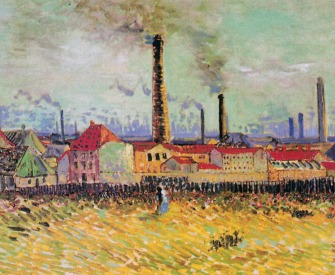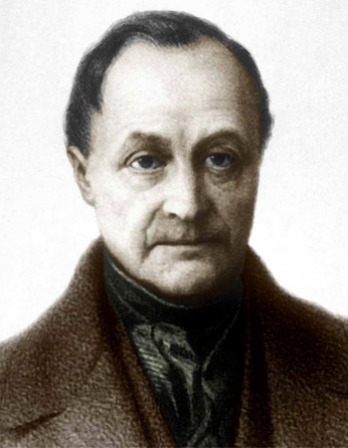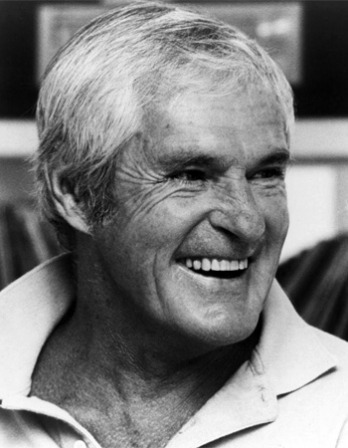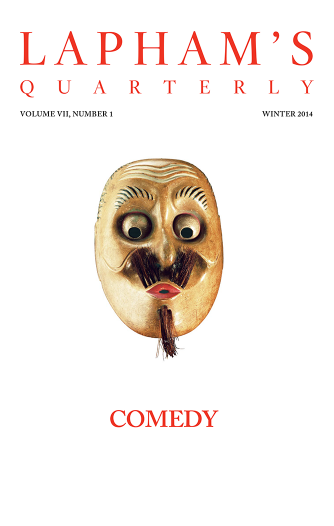Every individual existence goes out in a lonely spasm of helpless agony.
—William James, 1902Squeak & Gibber
Humanity’s greatest feat of rationality lies in the explanations we use to grapple with our own mortality.
By John Crowley

Death on a battlefield, atop a horse riding towards the left, wearing a hat with many feathers, other figures of Death battling to left and right in the background, by Stefano della Bella, c. 1646. The Metropolitan Museum of Art, Bequest of Phyllis Massar, 2011.
I once found myself, through a chain of circumstance too long to recount, a pallbearer at the funeral of an elderly Conservative Jew I hardly knew. The funeral was conducted by a Hasidic rabbi, and as he led us carrying the coffin to the grave, he had us stop periodically—seven times—while he prayed aloud. I asked him later the reason for this. He claimed that it was so that the ascending soul could cast off the weights and wrappings it had acquired from the planetary spheres it had passed through to be born on earth, and through which it must ascend to reach the next life.
The Hasidim more than other Jewish sects are committed to a life after death—some believe that dead souls can appear to the living. In the oldest Jewish traditions, though, there is little emphasis on a next life; there are almost no revenants or ghosts in the Hebrew Bible, and no afterlife that impresses us as being more than a name for death itself—Sheol is as featureless and blind and inactive as the grave it stands for. The tradition of the soul’s escape from the earth and the body through the spheres derives from Neoplatonic philosophers of late antiquity; I don’t know how it might have become implicated in the funerary rites of the Lubavitcher Hasidim, and no other rabbi I’ve talked to has ever heard of this explanation for the practice, but I was there on that day, giving aid to a soul on its journey. And yet I also know that on the anniversaries of his death, the man I helped to bury is visited by his relations, who place small rocks on his headstone, and pray that he may rest there in peace.
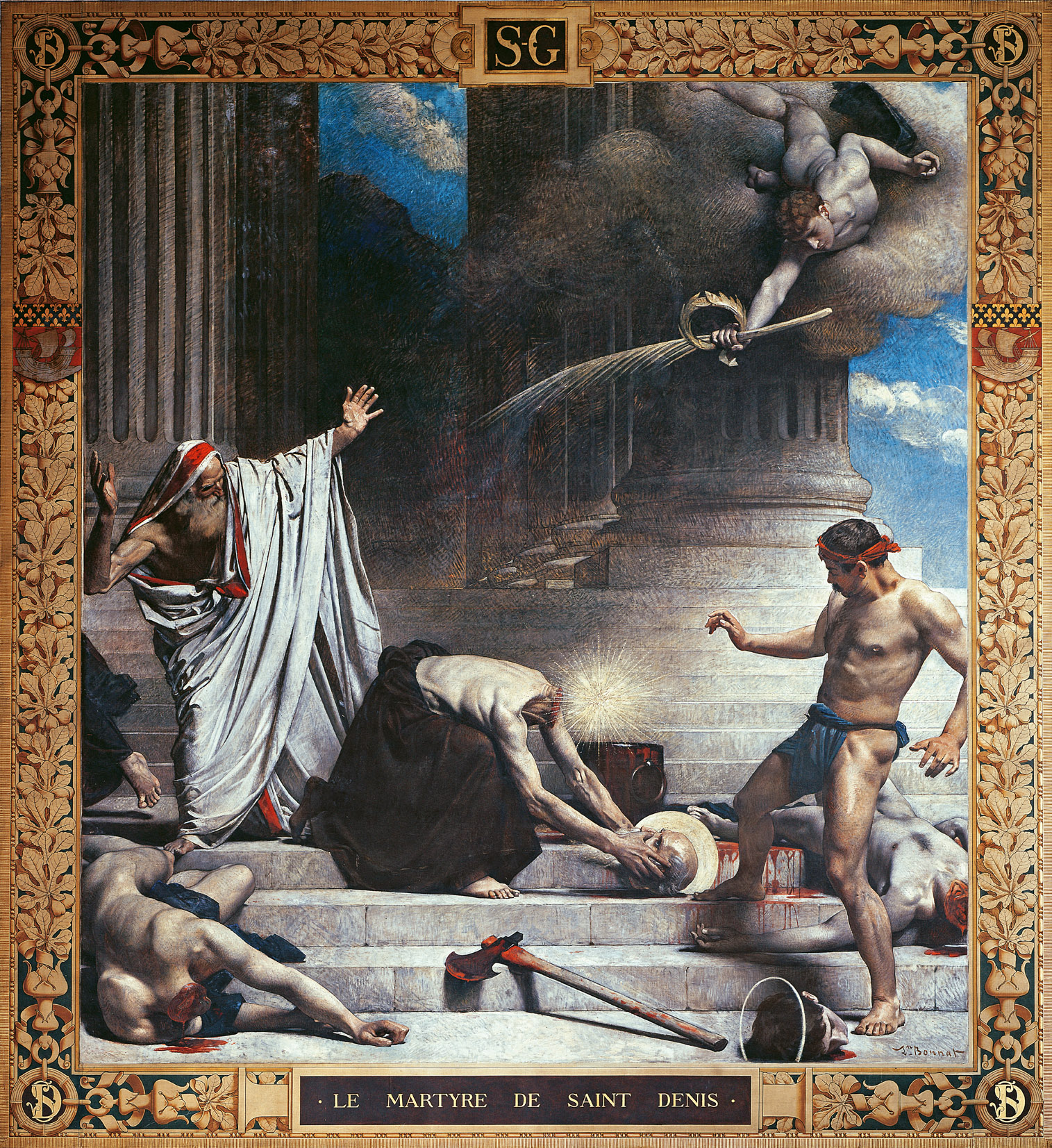
The Martyrdom of St. Denis, by Léon-Joseph-Florentin Bonnat, c. 1885. Panthéon, Paris, France.
I sometimes think that humanity’s greatest feats of rationality lie not in the useful discriminations and distinctions made by physics or philosophy within the continuum of life and time but rather in the inventions and explanations we have devised to grapple with the unresolvable ambiguities of our mortality. Among the most ramifying and manifold of these has been our understanding of what happens to us when we die, where people we have known alive go at death, and what they are and do there. The world over, we have held multiple accounts of the places death takes us simultaneously in our minds and hearts without feeling a compulsion or even a need to choose among them. That Mother is looking down from heaven upon us even as we place flowers on the grave where she lies causes most of us no cognitive difficulty. That she went down under that earth, and simultaneously up into the sky, but also appears beside our bed in the night to advise or complain, dressed in the clothes her living body once wore, seems harder to swallow—but in most cultures throughout history we haven’t been at a loss to accept it: My father, in his habit as he lived.
Our beliefs about death and where the dead are constitute the prime human instance of what John Keats termed negative capability: “When a man is capable of being in uncertainties, mysteries, doubts, without any irritable reaching after fact and reason.” Keats was describing what he thought of as a special power of the great poet, but it’s not just the poets who are granted this capability, it’s all of us. There can’t be death and yet there is death: the collision of these certainties makes possible a sustained ambiguity wherein lies the unending fruitfulness of our relations with the dead, and theirs with us.
My dead self is not identical to my dead body, but the two are not easily extricable. The belief has been widespread that our selves persist in our bodies for a certain time after death, puzzled or afraid, reluctant to leave. For a day? A week? A month? The bodies of the secretly murdered bleed afresh in the presence of their murderer (or so it was long believed). Hindu bodies are regarded as alive throughout their (very painful) cremation, right up until the chief mourner breaks the skull so the soul can exit. Certain saints’ dead bodies remained fresh and unrotted for decades, and how, if not inhabited in some sense by the saint? At an old-style Irish wake, the dead guest of honor in its coffin was addressed familiarly, and in response to all the jollity might even get back up again—as in the song that gave James Joyce his title. A Tibetan lama will read the Book of the Dead beside the wrapped body of a dead person over the course of many days as the person makes the difficult transition from one earthly incarnation to the next; the title of the text known to the West as the Tibetan Book of the Dead is more properly called Liberation Through Hearing During the Intermediate State. The dead we watch over can hear us; perhaps they can see. De mortuis nil nisi bonum. Put pennies on their eyes.
The bodies of those hated in life have been, and in some places still are, hauled up on lampposts or otherwise publicly displayed, to be humiliated and given what for—maybe only to prove to their enemies or victims that they are indeed dead and powerless, but surely also out of undiscerned impulses to deprive the dead person of rest and easy passage. It’s an insult which the dead are intended to feel. The pro-Carolingian Pope Formosus died in 896, but a successor and anti-Carolingian rival had him exhumed, propped on a throne in papal robes, and put on trial—the so-called Cadaver Synod. He was denounced and, unsurprisingly, found guilty of various crimes; three fingers of his right hand (those consecrated for handling the Host at Mass) were severed, and the body was thrown in the Tiber. Eventually it floated ashore downstream, where it promptly began working miracles, suggesting that whatever had been done to Formosus’ body, his functioning self was operating through it on behalf of believers.
The bodies of saints, or parts of their bodies—bones, hair, nails, tendons—were intensely revered at the time Formosus was tried; the frantic business of buying and selling relics made the observation of funeral rites and the inviolability of graves more necessary. The linkage of body and saint was so strong that the Church decreed at one point that the altar of every church had to have relics of a saint within it. The rule was still in force when I was young, and as an altar boy I was told that yes, parts of a saint were within the heavy altar stone of our tiny parish church (though not which parts, or which saint).
Did the high value placed on the dead bodies of the sanctified result from the Christian idea of an ultimate physical resurrection, that we will see God in our flesh? The project of Christianity to subsume the various deaths we suffer under a single rubric—I die with my body’s death and go under the ground, but I wake with my body at the last trumpet and find myself alive again—is one of the great feats of rationalizing that the death experience has ever undergone.
The Pharisees and Essenes of Jesus’ time did posit an eventual restoration of the reconstituted people of Israel, but when Paul, a Romanized Jew, experienced the Resurrection of Jesus from the dark and smelly tomb, what he conceived—and saw as promised to every person who believed in Jesus—was a physical body, the same body as went in, only now all alive, healed of its death pains (but not their marks), glorified, made new, and never to die again. O death where is thy sting? O grave where is thy victory? In the tradition from which Paul sprang there is no human life but in the body, so the body is what must be rescued from death through faith.
This concept of bodily life after life was always liable to paradox and self-contradiction, and over time, as the general resurrection was delayed longer and longer and graves remained closed and the bodies slept on, it somewhat lost its thrilling immediacy. The Greek-inflected theology that became Christian orthodoxy posited a divided destiny for the soul and for the body which it sheds at death, and gave primacy to the soul; institutional Christianity became a means of finding a good place in a spiritualized next world for that separated soul. Eventually the perfected body and the soul will be made one, and Christ will give a final judgment about the fate of each person—but this has always seemed a bit otiose; the fate of everyone except the handful remaining alive at the end has already been decided; damned or saved, they have been rejoicing or suffering since they died—as they do in Dante’s vision—and will just go on doing so thereafter.
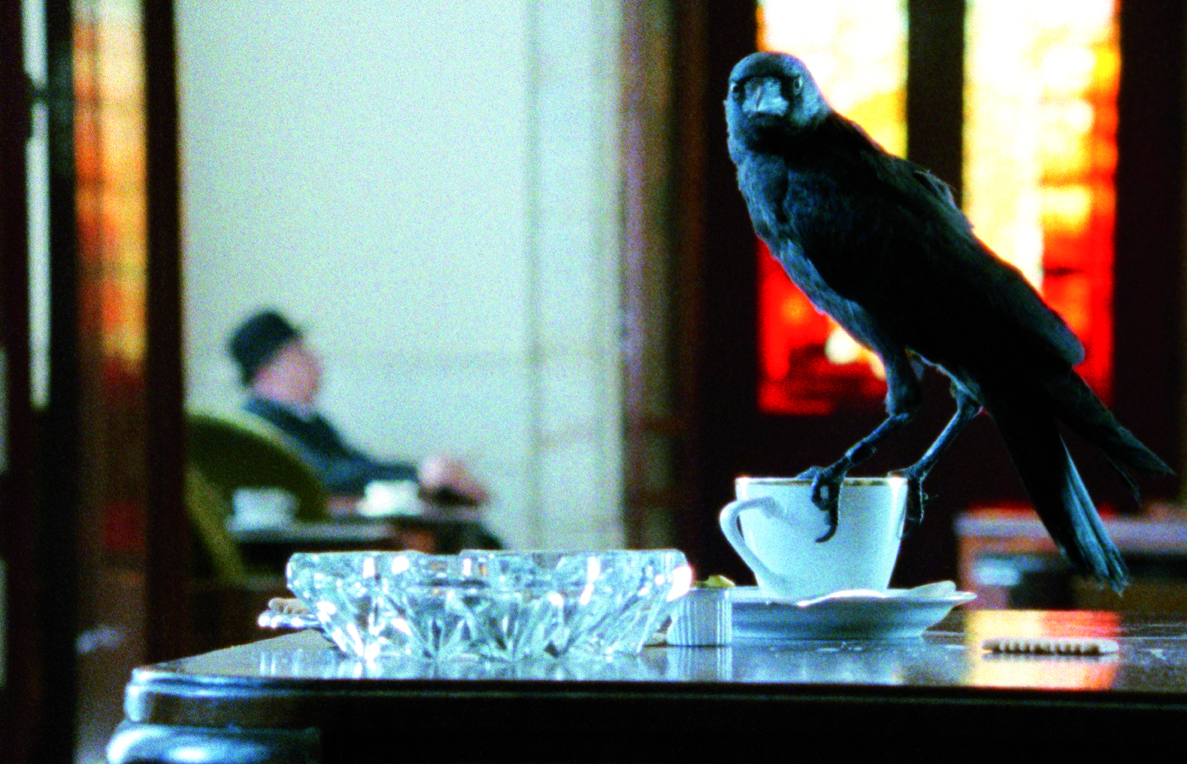
Film still from Looking for Alfred, directed by Johan Grimonprez, 2005. © Courtesy of zap-o-matik/Film & Video Umbrella/Sean Kelly Gallery.
The more austere sleep-wake dichotomy persisted in some Protestant thought. Stern New Englanders perhaps liked the Occam’s-razor economy of it. In a churchyard in Stockbridge, Massachusetts, the founding Sedgwick family has arranged its members’ graves in concentric circles, all facing inward, supposedly so that in the momentary confusion of the Last Day, as their graves are opened and they come forth, they will see familiar faces around them. Tourists are shown the place—the “Sedgwick Pie”—and get a chuckle out of the old simplicities our forebears held. The commonest locus nowadays for the radical idea that the body is the literal residence of the person after death, and under the right circumstances can get out of the confines of the grave and resume its life on earth—that would be the zombie movie. As a Catholic child I always found the prospect of the general resurrection of the dead creepy, and in my imagination it always took place at night.
The idea that what is to be done with the dead is to place them in a hole in the ground and cover them is so general throughout human history over the whole globe that it seems inevitable, self-evident, though of course it’s not universal. Cremation, disposal at sea, and excarnation (exposing the dead body to be cleansed down to the bones by scavengers) have their devotees, and they have their reasons. But mostly we bury. The Neanderthals took a major step up in our estimation of them when it was learned that they buried their dead, often with tokens of earthly life beside them (though whether the dead one’s own or the gifts of others, intended for use in a future life or simply an act mourning, remains unknown).
The Neanderthals possess our DNA, and we theirs; we bury too; maybe we learned it from them. Giambattista Vico (1668–1744), a forerunner of cultural anthropology, suggested that the Latin word humanitas derived from humando, burying. Thus humus is bound up with human—as Robert Pogue Harrison puts it in The Dominion of the Dead (2003). We are human insofar as we remember our dead and know where they are. Harrison says that the homes of the dead humanize the land; for most of history almost all humans—leaving aside the effects of wars and migrations—lived in close proximity to the graves of their forebears, and millions still do. We the living are the link that connects the dead to the unborn—“Through their dying the dead return to a realm of origins from which both the living and the unborn draw life.” The river of life passes through the grave, as the old Bahamian lullaby says: “The River of Jordan is muddy and cold/It chills the body, but not the soul.”
But let’s be clear: we may believe that we hide the dead in their crypts (the word crypt comes from the Greek kruptos, which means “hidden”) for their own safety, or to honor them, or (depending on culture) to mark their dwelling places so their souls can more easily find their way back to be joined to them. But it’s also to get them away from us and into a place from which they can’t return. Funeral practices around the world, from earth burial to cremation to encryption, derive in some measure from our need to keep the dead away. They have no place among us, and much as they may long to sit in their old armchair or meddle in their surrendered businesses, like restless retirees, their continual presence among us would make the conducting of our ongoing lives impossible.
To keep the dead from a decent burial is an insult to them, but it’s also a threat to the living. The extravagant grieving at funerals in many cultures, the lavish expenditure on funeral meats and goods, are not only expressions of attachment to the dead but also of hope that a good send-off will make it clear that their place is now in lands other than this one. We loved you, we will remember you, don’t come back.
But they do. If all the ghosts who refuse their banishment and wander among the living could be seen at once, they would far outnumber their living relatives. Like successive layers of transparent film, they would accumulate, eventually to make an opacity, and we’d see nothing or no one else. Outside of the movies, modern ghosts tend to be little more than a chill at the nape of the neck, a knock in the darkened hall; but the hungry ghosts of Japanese Buddhism (gaki) were “somaticized,” says William LaFleur in his study of the phenomenon, Hungry Ghosts and Hungry People—they always appear (at least in paintings and prints) with the swollen bellies and scrawny necks of the malnourished. Their hunger was dangerous, but it also accounted for why turds dropped by the highways disappeared so quickly.
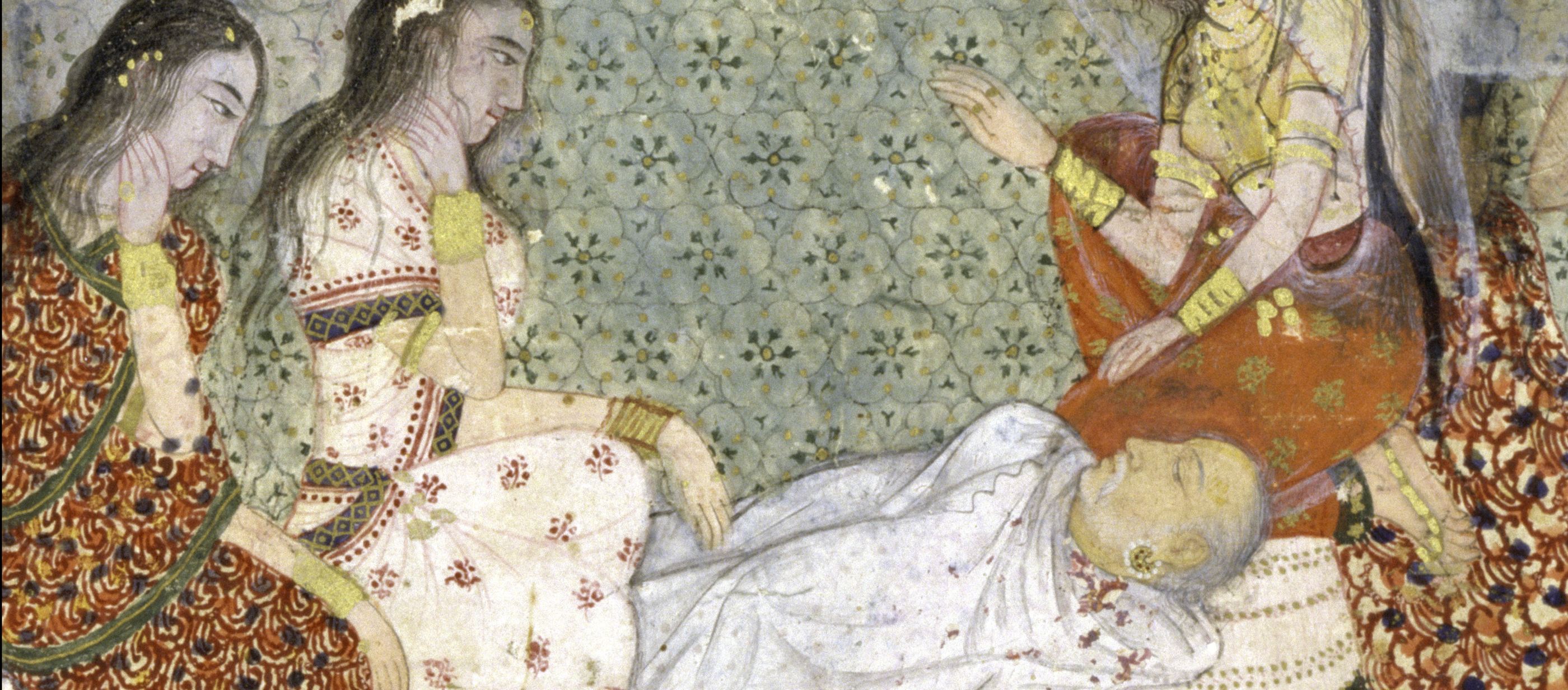
Death of King Dasharatha, father of Prince Rama, detail from a c. 1605 illustrated manuscript of the Ramayana. The Metropolitan Museum of Art, Cynthia Hazen Polsky and Leon B. Polsky Fund.
Ghosts are unlaid: they don’t wander where no one is; they return to the places and to the people they knew, in whom they are still alive and restless. “Just as burial lays the dead to rest in the earth,” says Harrison, “mourning lays them to rest in us.” Many of us live far away from where our dead are buried; many don’t even know where that place is, and many couldn’t return there even if they did. We can’t always reach them with our flowers and gifts, nor with small rocks placed on graves. Mourning to lay the dead to rest in us is what we have, and the unquiet dead reach out to us, then, not from their graves in earth, but from our hearts in dreams.
There was a time when dead souls could be sought for in their own land, a place far away and hard to reach, but somewhere on earth. There they were often as nearly nonexistent as we could imagine them, and yet still vividly themselves—which means something like their selves when alive, the self that shines constantly through the whole of the living body like the bulb in a Tiffany lamp. The Greeks named this cloudy remnant psyche, which originally had none of the large meanings that would accrue to the word; it meant simply the last breath exhaled at death. It persisted, and could form a person-shaped eidolon, or image, that displays all that we can recognize the person by, but attenuated, vanishing, and unavailable to touch, our least deceivable sense. Their realm was in Hades, far across the great river Ocean. They hate it there—so Homer says. Even Achilles in the underworld is uncomforted by his eternal fame among the living; if he could, he’d rather be a peasant’s slave and live.
I’m doomed to die, right? Why should I care if I go to Hades either with gout in my leg or a runner’s grace? Plenty of people will carry me there.
When Odysseus, following the instructions of Circe, reaches the land of dead souls, he pours the blood of a black ram into a ditch he has cut with his sword, and blood—forever and everywhere the most living thing that there is about the living—brings forth, in Alexander Pope’s translation, “the phantom nations of the dead.” “The ghosts came trooping up from Erebus,” Samuel Butler’s translation reads, “brides, young bachelors, old men worn out with toil, maids who had been crossed in love, and brave men who had been killed in battle, with their armor still smirched with blood; they came from every quarter and flitted round the trench with a strange kind of screaming sound that made me turn pale with fear.” Elsewhere in The Odyssey, Butler calls this sound that is no sound “gibbering,” which perhaps he got from Shakespeare: after Caesar’s murder “the graves stood tenantless and the sheeted dead/Did squeak and gibber in the Roman streets.”
The blood of sacrifice allows Odysseus to see and hear his mother, but though he tries three times, he can’t embrace her—is she only an illusion? She answers, in Pope’s couplets:
’Tis not the queen of hell who thee deceives;
All, all are such, when life the body leaves:
No more the substance of the man remains,
Nor bounds the blood along the purple veins:
These the funereal flames in atoms bear,
To wander with the wind in empty air:
While the impassive soul reluctant flies,
Like a vain dream, to these infernal skies.
“Infernal skies” is a nice oxymoron, expressive of the paradoxes of cremation, which the Greek and Roman nobility often preferred to burial, because it bore the remains of the deceased Up, not Down, to wander with the wind rather than rot in the grave. Up is always better. Of course now the heavens are no longer Up in any defensible sense; we don’t live and die on an earthly plane with a cold and dark world below us and a bright pure realm above—except when we do. Harold Camping, John Hagee, and the others who dream of the Rapture—when living Christians will be snatched up to be with the Lord in the air while the rest of us suffer—might be hard pressed to say just how far they’d have to go, or where to exactly, outward from the earth; but they know where Up is, and where Down. We can all point to heaven. “The soul of Adonais, like a star,” writes Percy Bysshe Shelley of the dead John Keats, “beckons from the abode where the eternal are.” Keats himself—in another sense—lies under a stone in the Protestant cemetery in Rome that reads here lies one whose name was writ in water. Devotees lay flowers for him there.
Woody Allen said that he didn’t want to achieve immortality through his work—he wanted to achieve immortality by living forever. St. Augustine knew his congregation wanted that too, as much as they wanted heaven. “I know you want to keep on living,” he told them. “You want to pass from this life to another in such a way that you will not rise again, as a dead man, but fully alive and transformed…Mysteriously, the soul wishes it, and instinctively desires it.”
The American Christian conception firming up ever since the Second Great Awakening has drawn ever closer to that wish. It passes over or forgets the moldering corpse waiting in the grave for its soul partner. You go to heaven directly at death, often sighting your destination even as you slip away from your loved ones—and heaven is a “land where we’ll never grow old” as the old Carter Family gospel song has it, where everything is as it was on earth, but perfected, with the soul as the body; the dross evaporated, the tears wiped away, time not passing, Eden restored. There, in eternal springtime, we will live in a house or mansion (one of the many that Jesus tells us are in his Father’s house), certainly with Mother and Father and those “who have gone on before,” even possibly (opinions differed) with Fido. All this is so common now, pictured on the covers of Victorian sheet music and mourning cards, the subject of countless fervent wishes, sentimental songs, and lots of jokes, that it may be forgotten how unlike the orthodox Christian heaven it is; its unlikelihood isn’t at issue, but how did it come to be?
In 1745 the natural scientist and mining engineer Emanuel Swedenborg experienced a revelation in which he saw the world of spirits, heaven and hell. For the rest of his life he came and went to and from those realms and described the education he received from the angels there. All things earthly correspond to heavenly originals, he learned. Death is simply the understanding that our earthly life and the physical body were masks, representations, or shows—metaphors, in effect, for heaven and the spirit.
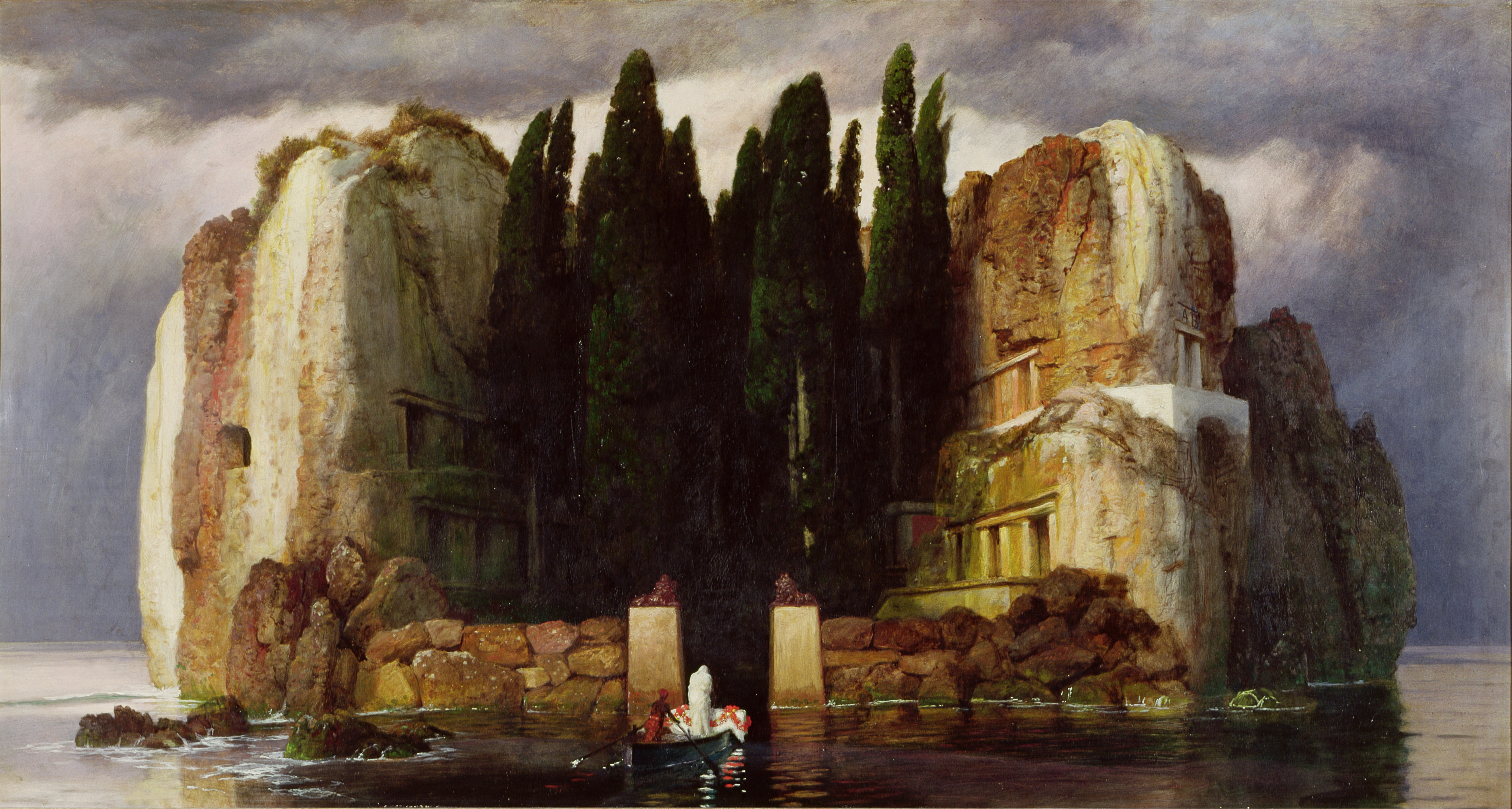
The Isle of the Dead V, by Arnold Böcklin, 1886. Museum der bildenden Künste, Leipzig, Germany.
Swedenborg’s effect, particularly on American Protestant beliefs and assumptions, was great—though submerged now. We all belong in heaven; souls who fail to get that far do so not at all because they have earned punishment or divine wrath but because hell is what suits their confused or willful nature; the grumpy and malicious will learn eventually and move upward. We will marry there—indeed, if we have loved truly, we’ll have the same love in heaven. Love is the highest value, in effect the substance, of heaven. The uncounted milliards of angels that fill the universe are not superior beings made specially by God but simply human souls, among them our dead children. The universe has the shape of the human body, as William Blake—who for a time was devoted to Swedenborg’s teachings—has it:
For Mercy has a human heart,
Pity a human face,
And Love, the human form divine,
And Peace, the human dress.
Where are the dead? They are in the galleries, gardens, and cities of heaven, as angels; some higher, some not so high. In fact that’s also where they are before they die; they just don’t know it. In Swedenborgian terms it’s most accurate and complete to say that heaven and the angels are here; the question to be answered is where the living are.
Invisible bodies, says William LaFleur, can be done away with much more easily than visible ones. Since they take up no physical space, ridding ourselves of them involves no bloodletting; ceasing to ponder their residence or nature will do it, and is part of a cultural aspiration to modernity. Spiritualizing the dead removes the need for far-off Isles of the Blessed or the toils of underground hells; their ever-growing communities are effectually nowhere, which has had the consequence along one parameter of bringing them closer to us: as close as we are to ourselves. The lands of the dead that the early spiritualist mediums heard about were often featureless as well as placeless—maybe because they were only heard about, not seen. There’s speculation that mediumistic overhearing was given new power by the spread of the telephone—we all became familiar with disembodied voices speaking into our ear, near but far away. Hamlet, pondering the human condition after death—in particular his own—asserts that it’s impossible to know anything of it for sure, because death is “an undiscovered country from whose bourn / No traveler returns.” Of course his own father has recently returned, and from the familiar country of a standard Christian purgatory; either Hamlet (or Shakespeare) has forgotten that momentarily, or Shakespeare knew the question was unanswerable: not because it had no answer, but because it had so many.
The life of the dead consists in the recollection cherished of them by the living.
The question remains our own, and as open as ever. As knowledge of the brain and its workings has expanded, so has the belief that consciousness is a biological phenomenon that can’t survive physical death—but at the same time the cloudy hope appears that the living mind might be digitized and uploaded to new containers, escaping the dissolution of the “meat package” that limited its scope. In much of the world the physical bodies of the dead are no longer at risk of desecration—or even available at all, mere ashes—but vengeful writers now gain access to archives of life data that can bring down dead leaders and celebrities; intimate memoirs tell us the worst about dead parents and grandparents; and all this is perhaps just as hurtful to those forebears now waiting for us on the other side, if indeed anything is hurtful to them. Certainly Dante, down in hell collecting material for a book, met several who wanted to know about their reputations back in Florence.
In sheer numbers the dead are more available to us than ever before in our history. Modern urban persons may live less in fear of their personal dead coming to their beds’ ends to stare at them, and because of that might tend to their everyday needs less often; but in fact we see more of them at large. I once made much of my living writing documentaries about historical events, created from photographs and films saved from the past, and I spent many days sifting through the faces and gestures and clothes of the dead, sometimes speaking, more often silent. In the dimness of the editing room as I ran their spectral black-and-white remains back and forth, and they went on making the same gesture or taking the same step over and over, it became clear that the image archives (which become ever deeper and easier to search) are the great necropolis of our time: a republic of the dead where the great majority live their lives—for as long as photographic emulsions and digital media will last—in what W.B. Yeats called “the artifice of eternity.”
It’s said that we don’t face death nowadays with the steady gaze we once did, or willingly admit its possibility; that death is failed healthcare; that we hustle the dead out of the land of the living and out of sight and mind too, unreverenced and untouched. And it’s true that in many (far from all) places in the world the dead aren’t handled, washed, and kissed by their friends and family, and in such cultures their afterlives are different, perhaps lessened. But I think that the disambiguation of soul and body, of alive and dead, of conscious and extinguished, that is aimed at by modern biology and physiology—to say nothing of the physics of space and time in which Up and Down make little sense—may actually further enrich the life of the dead and expand our powers of negative capability. That a deracinated world must consciously create the lives and home places of the dead where once traditions were available to instruct us in such things doesn’t mean we’ll stop telling ghost stories or dreaming of our dead relatives; fictions of survival in the land of the dead, or of the revenant among us, will not cease to have power just because that power is the power of fiction. We are encouraged by swiftly evolving technologies of remembrance and recovery to imagine that soon the dead will be alive right with us, in eternal digital bodies, Swedenborgian angels who contain within themselves the places where they are and go—a land where we’ll never grow old. If that’s a fable too, and the hopeful digital dead will vanish away as all the dead of Erebus have vanished, or the frozen selves now spoiling with great slowness in cryogenic tanks, we can surely come up with others. Like love, death can always conquer reason, even as it forever remakes meaning. The Angel of Death will be the last to die.
